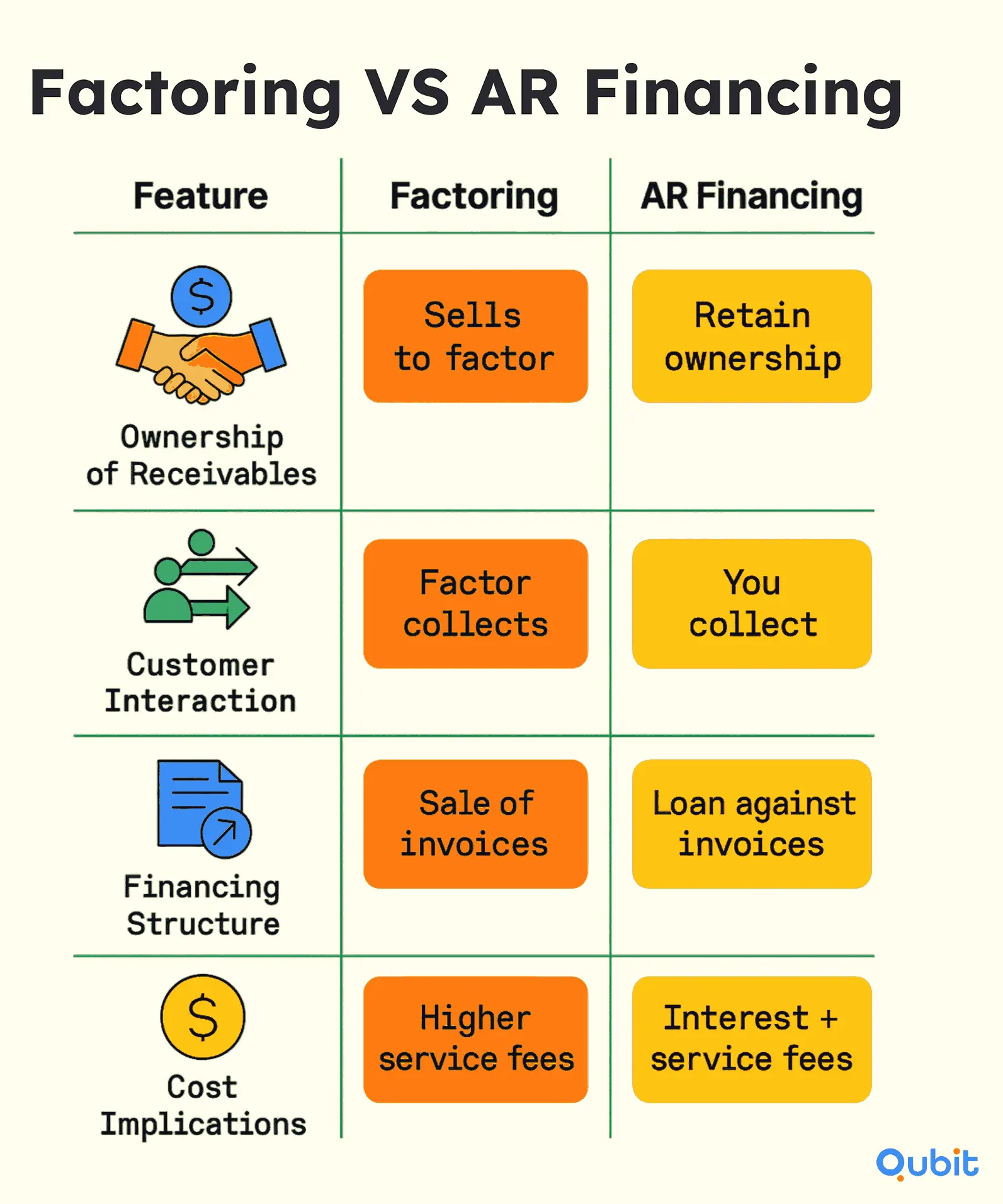Growing fast feels amazing, until your customers take 60, 90, or even 120 days to pay. When you’re gearing up for a growth round, delayed cash can stall everything. Two solutions promise relief: accounts receivable insurance and factoring. One protects you against customer non-payment. The other converts invoices to instant cash.
In this post, we’ll compare cost, control, and hidden trade-offs. By the end, you’ll know exactly which tool fuels your next growth leap.
Let’s explore how these tools can help businesses overcome payment risks and maintain financial stability.
What is Factoring?
Factoring is a financial solution designed to provide businesses with immediate cash flow by selling their unpaid invoices to a third party, known as a factor. This process allows companies to access funds tied up in accounts receivable without waiting for customers to settle their payments. The factor typically advances 75% to 90% of the invoice value once the service or product delivery is confirmed, offering quick liquidity to businesses in need.
The factoring company assumes responsibility for collecting payments from the customers, which can streamline operations for the business. However, it’s important to note that factors often notify customers directly about the arrangement, a practice known as notification factoring. While this ensures transparency, it may impact customer relationships, as some clients might perceive the involvement of a third party differently.
For businesses seeking practical applications of factoring, tools like those offered by Accord Financial illustrate how factoring solutions can be structured to meet diverse needs. By advancing a significant portion of invoice value upfront, factoring helps businesses maintain steady cash flow, especially during periods of financial strain or growth.
What is Accounts Receivable Financing?
Accounts receivable financing is a secured lending solution that allows businesses to access liquidity by using unpaid invoices as collateral. This financing method is particularly beneficial for companies seeking to bridge cash flow gaps without relinquishing control over their accounts receivable. Unlike factoring, where the responsibility for collections shifts to a third party, businesses utilizing accounts receivable financing retain full control over managing and collecting their outstanding invoices.
The process typically involves a lender advancing a percentage of the invoice value, often ranging between 75% and 90%. This advance provides immediate cash flow to the business, enabling it to cover operational expenses or invest in growth opportunities. The remaining balance, minus fees and interest, is released once the invoices are paid by the customers. Interest is charged on the outstanding amounts, making it essential for businesses to carefully evaluate the cost-effectiveness of this financing option.
This form of financing is ideal for businesses with reliable customers and predictable payment cycles, as it ensures steady cash flow while maintaining control over customer relationships. By leveraging unpaid invoices as collateral, companies can unlock liquidity without taking on traditional debt or sacrificing equity.
Differences between Factoring and Accounts Receivable Financing
Understanding the nuances between factoring and accounts receivable financing is crucial for businesses aiming to optimize cash flow. While both methods provide access to immediate funds, they differ significantly in structure, ownership of receivables, and cost implications.

Ownership of Receivables
One of the most notable distinctions lies in the ownership of receivables. Invoice factoring involves selling your accounts receivable to a third-party company, known as a factor. Once the sale is complete, the factor assumes full ownership of the receivables and collects payments directly from your customers.
In contrast, accounts receivable financing operates as a loan secured by your receivables. Here, the business retains ownership of the receivables and remains responsible for collecting payments from customers. The financing company simply provides funds upfront based on the value of the receivables, which are used as collateral.
Customer Interaction
Customer relationships can also be impacted depending on the chosen method. With factoring, the factor takes over the collection process, meaning your customers will interact directly with the factoring company regarding payments. This shift can sometimes affect customer perceptions, as they may view the involvement of a third party as a sign of financial instability.
On the other hand, accounts receivable financing allows businesses to maintain control over customer interactions. Since the business continues to manage collections, customers are less likely to notice any changes in operations, preserving trust and continuity.
Financing Structure
The underlying structure of these methods further highlights their differences. Factoring is not a loan; it’s a sale of receivables. The factor pays the business a percentage of the invoice value upfront, typically ranging from 70% to 90%, and then collects the full amount from customers. Once the factor receives payment, they remit the remaining balance to the business, minus their fees.
Accounts receivable financing, however, functions as a loan. The financing company provides a cash advance based on the value of the receivables, and the business repays the loan with interest over time. This structure can be advantageous for companies that prefer to avoid selling their receivables outright.
Cost Implications
Cost is another critical factor to consider. Factoring fees are generally higher because the factor assumes the risk of non-payment. These fees can include a percentage of the invoice value, service charges, and additional costs for managing collections.
Accounts receivable financing tends to be less expensive, as the business retains the risk of customer non-payment. Costs are typically limited to interest on the loan and any associated service fees. However, businesses must carefully evaluate whether the lower cost outweighs the responsibility of managing collections and the risk of bad debt.
Choosing the Right Option
Selecting between factoring and accounts receivable financing depends on your business’s priorities. If immediate cash flow and outsourcing collections are your main goals, factoring may be the better choice. Conversely, if maintaining customer relationships and retaining ownership of receivables are more important, accounts receivable financing could be the ideal solution.
When to Choose Factoring
Choose factoring if you:
- Serve large, creditworthy clients whose invoices factors are comfortable advancing against.
- Need cash today for a critical sprint (e.g., a big trade show or product launch).
- Have limited collections bandwidth and don’t mind outsourcing.
When to Choose AR Insurance
AR insurance is ideal when you:
- Want to retain control of customer communications and brand experience.
- Are preparing for debt financing—insured receivables make you more attractive to banks.
- Have a diverse customer base and want protection across multiple accounts.
A Third Path: Trade Credit Insurance
Trade credit insurance bundles AR coverage with political-risk protection. It’s perfect for startups venturing into new markets or signing government contracts. In addition to default, it can cover:
- Political events like currency freezes or expropriations.
- Buyer insolvency in volatile economies.
Your review of insurance startup fundraising strategies outlines the broader funding landscape for insurtech ventures, offering context that enriches discussions on due diligence and term negotiations.
Practical Decision Framework
1. Map Your Cash Gaps
First, quantify how long it takes customers to pay. Run an aging report in your accounting system. Look at your Days Sales Outstanding (DSO)—the average days to collect.
Next, forecast your cash flow runway. Plot expected inflows against payroll and operating expenses. Identify months when cash dips below your safety threshold. Finally, prioritize invoices. Tackle the oldest and largest invoices first. This gives you clear visibility on true funding needs.
2. Crunch All-In Costs
Start by listing every fee and expense. For factoring, include the discount rate (e.g., 1–4% per month) plus setup and service charges.
For AR insurance, tally annual premiums, deductibles, broker commissions, and any audit fees. Don’t forget interest if you borrow against your policy. Also account for internal overhead. Factor in staff time for application, ongoing monitoring, and claims processing. These hidden costs can add up.
3. Gauge Team Bandwidth
Assess your in-house collections capacity. How many invoices can your team handle each week without backlog? Consider customer impact. Will outsourcing collections risk straining relationships? If personal service is core to your brand, you may prefer to retain control.
If bandwidth is tight, explore hybrid models: automate reminders, then hand off delinquent accounts to a factor or collections agency.
4. Align with Funding Goals
Decide if you need a quick sprint or sustained stability. Factoring suits tight deadlines—cash lands in days. Insurance builds a longer-term safety net. Think like an investor: rapid cash infusions show agility, but they can also signal financial stress. Insured receivables, on the other hand, strengthen your balance sheet.
Match your choice to your runway plan. If you’re closing a Series A next quarter, sprint financing might win. If you’re eyeing Series B in a year, insurance positions you for better terms.
Conclusion
Understanding the nuances between factoring and accounts receivable financing is essential for businesses seeking optimal growth strategies. Factoring involves selling your invoices outright, transferring ownership and customer interaction to the factoring company, while accounts receivable financing retains ownership and control, offering a loan against your invoices. The cost structures also differ significantly, with factoring often including service fees and financing costs, whereas accounts receivable financing primarily involves interest rates.
Choosing the right approach depends on your business needs, cash flow requirements, and long-term goals. A well-informed financing strategy can empower businesses during critical growth rounds, ensuring stability and scalability.
If you're looking for expert fundraising assistance tailored to your unique needs, we’re here to help. Explore our services at Qubit Capital and take the next step toward achieving your financial goals.
Key Takeaways
- Factoring provides immediate liquidity by selling invoices at a discount.
- Accounts receivable financing secures loans using unpaid invoices while allowing businesses to retain collection control.
- Key differences include ownership of receivables, methods of customer interaction, and cost structures.
- Wise Business streamlines international payments with local account details and mid-market rates.
- A strategic financing decision is crucial for mitigating late payment risks and supporting growth rounds.
Frequently asked Questions
What is accounts receivable insurtech?
Accounts receivable insurtech refers to innovative technological solutions designed to provide insurance coverage and risk management for unpaid invoices. These platforms help businesses protect their cash flow by mitigating risks associated with delayed or defaulted payments.


 Back
Back



